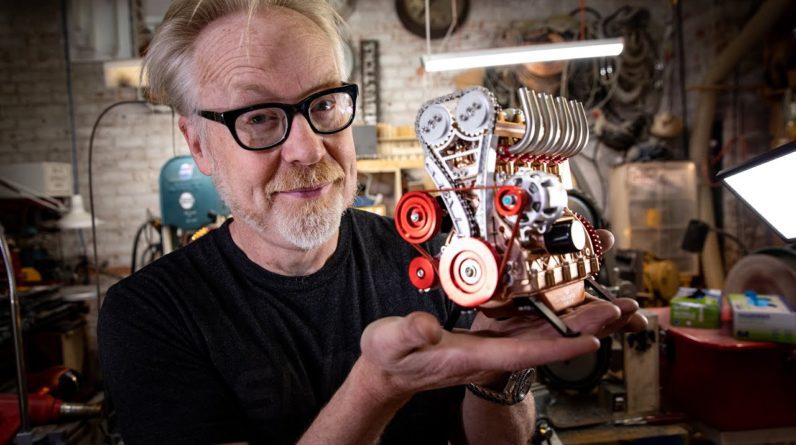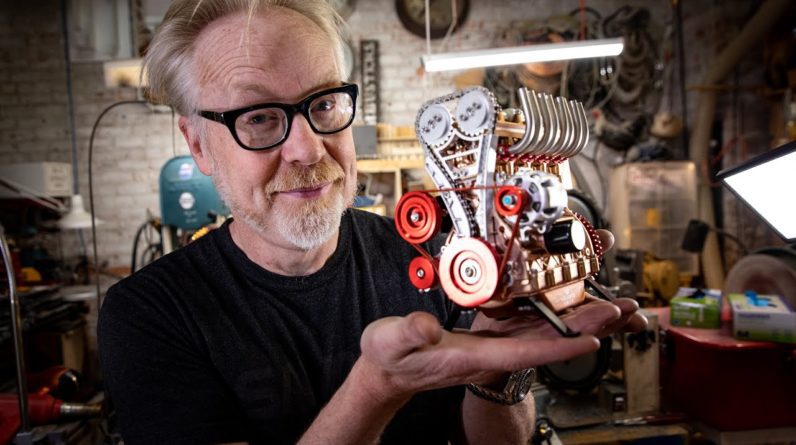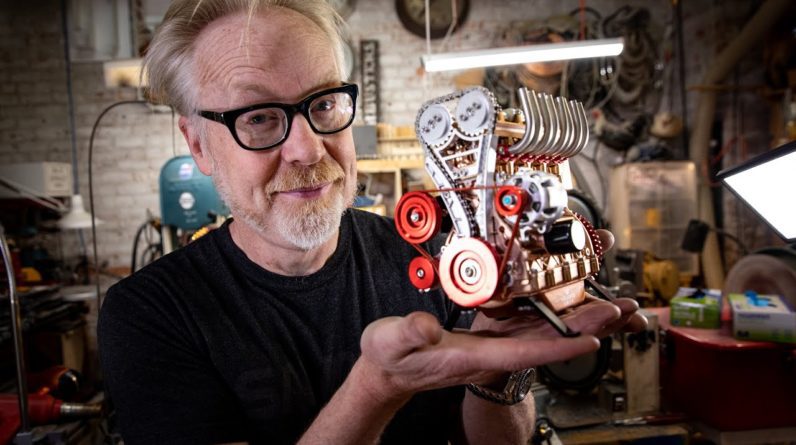(twangy music) – This is what shakes a woody apart. This is why after every adventure I have to go back with a big screw driver and tighten up all the joints in the body because these roads just shake it apart. (rattling) Well I think it's fair to say that there's no other place
on the planet that can possibly resemble what we're
about to go see right now.
We're here with Jeff Hacker, thank you, an old buddy who we've known each other for a couple of books worth,
cars that he's dragged home. This man is the authority
on fiberglass cars probably in the world, and he probably has
the biggest collection. We're only seeing a part of it here. This is called Fiberglass
Farms, where nothing is organic. So tell me what this car is. – This was called a Debonair and also known as
Adventure, one of the two. And they were produced in '54 and they were built, or
designed by, Philip Egan. Now some of your viewers
may know Philip Egan. Philip Egan was one of the
design team for the Tucker, along with Alex Tremulis. When they finished up, Alex
Tremulis went on to design cars like the Sun Goddess, as
I remember, for Kaiser and Philip Egan joined a
company as a consultant and designed this particular car, which I call it the Debonair. That sounds pretty.
– Debonair. Okay. So what kind of chassis is it on? – Well it was designed, unlike a lot of the cars here, the second versions of fiberglass cars were designed to fit on
full-on modified chassis.
What they were trying to
do is say, you know what, we realize it's hard to cut a chassis. And some of them were cut
with hacksaws back in the day. It's hard to weld the chassis, so let's build a car that
you take the body off and put a body on, be much easier. – Okay.
– Hagerty lists them at just about a 100,000 each
restored, which is nice. Now I don't know sometimes
with cars that are such limited production,
particularly American cars, since they weren't made
by Chevrolet, or Cadillac, or one of the big companies,
sometimes the values are hard to achieve, hard to get because people aren't familiar with them. How many of your viewers have ever seen the Ventura Debonair? So I started to say, when
we started researching we knew of none of these. It took us two or three
years to find the first one. They made six according
to Philip Egan's research. – And you have four? – Five. – Five, you have five
of the six ever built? – Five of the six, if they made six.
(laughing)
– So they could've made eight, maybe they made five. The records are never perfect. It's not like someone
wrote it down perfectly, but his recollection was
six of them back in the day. – I don't know a lot about
these cars in general, but I know about this one in particular. This is called a Victorous. But it's interesting, I
was writing a book called Motor City Barn Finds
a couple of years ago and I was in Detroit. And I got a call from Jeff
Hacker, who owns these cars, he said, guess what, Tom. I just found a new Victorous kit car. I said, that's interesting. Where is it, he said, in Detroit.
I said, son of a gun,
I'm in Detroit right now. He said, so am I. This is a kit car that
was built, I believe, on a TR3 or TR2 Triumph chassis. Fiberglass body, you can see the roof was cut for a sunroof. But there's not even a hole
yet for the back window. No back window in here yet. The trunk has been cut out. The windshield has only
been hacked approximately. You can see where the line is that was molded into the body. So that's where the windshield should go. Who knows what these hood latches are for. But this was a car that
people would build. They'd start off very enthusiastically, read about it in Hot Rod
magazine or Popular Science, and you'd send away for the kit. And the kit might be $500, a $1,000. You supply your own chassis, in this case a Triumph,
maybe in that case a Ford. Then the work started. You know, it's fun to take
the body off the frame and that's easy to do, but then, when you had to start
building the car yourself, and building in window mechanisms
so the doors rolled up, and building in latches, and
started to build your own dashboard and getting things working.
These cars took 2,000 hours to build. If you think about 2,000 hours, that's a full-time job, 50 weeks a year. A lot of people work 2,000 hours a year. So if you had a regular job, well this would double your job, or it would last for three years, or four years, or in this
case and in many cases, never even get done at all. They'd sit and languish in a garage, get put into the back yard, because it was just too much work. And like all these
cars, and the other ones he's got in other locations, he plans on restoring this car. But, boy. You know, he's got a couple
of guys that work for him that are very good at
finishing up these cars. So instead of 2,000
hours, they could probably finish this in 500 'cause
they just get on it, work quickly, they've
got the systems in place. But these things are littering the country in garages, outside of
garages, and a lot of them are just getting scrapped. It's really a piece of
American sports car history that shouldn't be forgotten. That people who couldn't afford a Jaguar, or an Aston Martin, or an MG, or wanted something a little more exotic than a standard sedan,
they could buy a kit and take the body off their Ford sedan, put this body on it and
suddenly have a sports car.
So some were finished, most were not, but they're all interesting. Now this is kind of a cheeky looking car. What are we looking at here? – This is a car called the
1955 Bangert Manta Ray. There are four known in the world. One is built on a Curtis
chassis, it's a race car. One is built on a custom
chassis, it's a drag car. Both are world famous. The third one is owned by me. We debuted it at Amelia Island last year. And it's based on the 1954
Buick Wildcat concept car.
In '54, '55, they started
opening up the fenders. Called open up clam shell fenders. And it was done, from what I
can tell in the styling books, to keep the brakes more ventilated. Disc brakes weren't the.
– Ah. – We still had drum brakes all four. And so this really helped
ventilate the brakes. We've got very famous pictures in the 50s and the styling of this
open kind of fender look some people seem to it polarizes people.
Either people like it
more, or they like it less. – Do the headlights go here or here? – Yes.
(laughing) The first ones came out here. And then, Noel Bangert,
who was a friend of mine, Noel passed away about 2010 or so. He designed this. He didn't have a brochure. He had a poster and he said, here are three different
ways you can make this car. And he wanted people, encouraged people to build them the way they wanted to. Headlights could go here,
that's how we did our car. Headlights could go here and we have a Bangert Manta Ray front end over there with that. And headlights could
go where you first said just outside the fender,
it really depended. It depended what they wanted. – [Tom] That's heavy fiberglass. – It's extremely heavy. And I'm not sure we can pull this open. We showed one before with
Ray Abraham last time on America Carna show. – Ray was here? – Yeah, Ray was here about two years ago. And so if you open this up. – [Tom] I mean that thing weighs. – You can see the construction also if you look on the inside.
– And that's steel pipe?
– Steel pipe, yeah. – [Tom] You see the
steel pipe reinforcement and the fiberglass just
kind of wrapped around it. – Which is good and bad. What you need to do is you have to have materials that flex in the
same way temperature wise. Otherwise, you start
getting fiberglass flexing different temperatures
and more quickly or slowly than the material underneath it, so it takes some expertise. This is actually a banjo.
– Yep. – Ford ran so that
would've been through '48 and a torque tube and this originally would've had a Ford
flathead in it most likely, which has when these I believe these are the motor mounts for that. I'm just trying to think, when we found this it had a Chevrolet 265, so it had already been updated, so these might actually
be for the Chevrolet. – Yep, okay.
– But we pulled that out. Is this the kind of stuff you want? – Yep, yep.
– Okay. – Yeah I could see how
that front end would be somewhat polarizing. And there's one over here
that does look like a Ferrari.
– Well that's one of
three cars that were done in the 50s that looked
like inspired by Ferrari. They were kind of cars, were the ones that looked like European cars but drive like an American cars. 'Cause if they drive like American cars that means you can get the parts in 1955 over the counter, if you
need a Ferrari engine well that was back in
the day when they were taking Ferraris and putting
Chevrolet engines in them. So this one was actually built, designed and built by Carl Luckenbach. Carl Luckenbach was about 20, 18 to 20, when he designed and built this. And he did it in his garage
near Detroit, Michigan.
Carl was later a student at
the Cranbrook Academy and then, I hope I'm doing his legacy justice. Carl currently lives in
Jacksonville, Florida but grew up and his company was in and around Detroit, I think Ann Arbor actually
is where his company was. – [Tom] His company was in Ann Arbor? – [Jeff] He what? – [Tom] He built these in Ann Arbor? – [Jeff] He built this. Just this one car.
– Oh, just this one car. – [Jeff] Most of what you find is, a lot of people who built a car like this, he designed it, he lofted
it, he sculpted it, he sanded and made plaster,
pulled the mold off it, pulled the body, and so forth. I think, I think, if he didn't pull a mold then this would've been male
molded where you actually create the car in plaster and
then lay down the fiberglass and then sand it and then
pull it off the mold.
So I don't think he made a mold. I think it was a male mold which meant a model first, that you
pull the fiberglass off of. – Pretty good looking
front end on that thing. – Well this is a 102 inch wheel base. He built it on 40s Ford chassis but made some modifications. He actually put in longitudinal
springs in the back, which was unusual since they came with a cross spring, a buggy spring. – Yeah, yeah, yeah.
– Still have the engine. The engine, here. – Such a shame with this engine? Yeah, go ahead. – It's the only car with a
Lincoln engine we've ever, let's just put this off the top.
If you grab it, then slide it down. It's a shame about this engine. We might be able to save it. Brand new. Zero miles.
– Whoa. – Maybe he took it six. Down the block and back is
what the family told me. And if you open up the valve covers. Let's see. See if you can take the valve cover off. – [Tom] Wow, clean as a whistle. – Except a few leaves.
– Holy. – [Jeff] We've got to get
this engine out of here. This has only been here a few months. But this engine has no miles on it. – [Tom] Look at the. – And it's also absolutely locked up. His family had access and
they bought a brand new crate motor right off the
sales floor, I think in '56.
It was a display motor,
what Carl was saying. And they put it in here. Now we tried, we opened it up, we found our first attack on this engine was that the whole
bottom end is locked up. It still has oil in it,
but it looks really tough. We have another engine to go in here, but we're gonna take a
second pass at this engine and see if we can actually get it going. – [Tom] Yeah, wow. – So I think this was an automatic. Oh, I think so. Yes. And he never finished the car. Left it, he went to college. So often that happened, never finished it. It was driving, it was running. And we hope to finish this one. We do usually finish about.
– [Tom] Does he know you have his car? – Oh yeah, Carl's, we have
a great video if any of the, any of the people who view
your show want to see, it's on our website or
YouTube page and all. They can see it. – So he lives in Jacksonville. Has he been down here? – When we were up in Detroit, we met him and we put
him and the car together. He didn't know where the car was, but we knew where Carl was. And the family that owned it
knew that Carl had built it 'cause they had bought it from his family. And so we said, Carl, come down.
I still remember because
it was 18 degrees. It was very cold. And even though I'm well
insulated, I'm not that insulated. (laughing)
Very cold. This car I've had for
whatever 1984 is to now, 2018. – What, this car?
– Yeah, Shark. I brought this back from San Diego. That's my second fiberglass car. The first one is actually we debuted with Bill Warner at 2013 at Amelia Island. And it's been on Auto Week
TV and Jay Leno's Garage. And this one is my next car to finish. – [Tom] And what kind of
drive train would this have? – These were Sharks.
This was the convertible Shark. You saw the other Porsche based Shark that we have on the trailer out front. And this particular Shark
was based on a Renault. All of the convertible Sharks were based on Renault 4CV or Dauphine. Very fun little car. I used to drive it to
high school and college, the other one, before we retired it and waited 30 years to restore that one. – Wow, why are you into
these kind of cars? I mean what brought you into this? – I love cars. When I came down here,
I lost access to all my great older friends who had heavy iron, you know, the Marmons and
the Packers and so forth. But I found this car, not this very one but the other one. And so I became interested
in fiberglass cars. And this was built in
St. Petersburg, Florida. And I went to the library
and found a whole section on the Sharks and Henry
Covington who built the coupe. And the others were designed
by Glenn Gums in the company.
And they only made six
convertibles and six hardtops. And then I went off to college. I restored one. – [Tom] So what'd you make a career in? – [Jeff] I was working for a
company called Eckerd Drugs. My background's a PhD in industrial organizational psychology. – You know, I think that about does it. Jeff Hacker, I try to make a point to come here every 10 years. – Yes, it's good to see you, Tom. – So I'll be back in what, 2028. – Okay, well we look forward to that. (laughs)
We'll have more cars. – Thank you, thank you so much. – Great to see you again. – You know, I don't know. I guess this looks like
a '51 Mercury custom. This one, at least the front end, looks something like a
'55, '56 Thunderbird..






